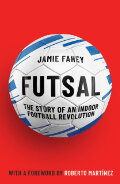‘Iniesta trained with us. Oh, he was very good…’
EXCLUSIVE extract: Chapter 15, Spain: Fútbol sala: la fundación
WHEN MARC Carmona speaks, it pays to sit up and listen. So that’s exactly what I do, nestled in the principal lecture room in the swish educational wing of La Masia, the nerve centre of FC Barcelona. The building is actually the second iteration La Masia, the famous rural farmhouse where the likes of Lionel Messi, Andrés Iniesta, Xavi Hernández and the legion of Pep Guardiola’s tiki-taka foundlings were reared on a nutritious diet of tactics and tapas. Carmona is the most successful coach in the Barcelona futsal team’s history, the master tactician responsible for an unprecedented period of glory in fútbol sala, one of the club’s five professional sections. ‘One day Iniesta trained with us here because Nike wanted to present a special award for futsal,’ recalls Carmona, reflecting on the symbiosis between the two sports played with a ball at the feet.
‘We trained with a lot of respect because you can imagine, if we were to injure Iniesta!’ he laughs. Iniesta’s mutual respect was tangible.
The midfield maestro admits that playing futsal as a boy gave him an innate game nous that later set him apart in the cut and thrust of peak Pep-ball. In the futsal hall next door to La Masia, Iniesta didn’t struggle as such – ‘oh, he was very good,’ remembers Carmona – but afterwards he expressed appreciation for the difficulty of playing futsal at the elite level. ‘What I love is their skill with the ball, the intensity of the moves, the sidesteps, the blocks, the passing,’ Iniesta told Nike.
“For me, futsal is clearly a very good practice for both football and futsal”
– Marc Carmona, FC Barcelona’s most successful ever futsal coach
‘I take my hat off to futsal players because it’s extremely difficult. Watching it on TV is different to when you train or play it for real.’ In another hat-tip to the small-sided game, he pointed out that as a professional footballer the ‘tactical elements and movement in the game gets lost on you’.
Carmona’s period in charge of the futsal team overlapped with his friend and fellow coaching icon Guardiola’s equally astounding impact in the eleven-a-side game. In a twelve-year stint as fútbol sala head coach, starting in 2004, the former footballer (until the age of nineteen) and futsal player (until twenty-nine) took Barcelona’s futsal club from the second division to the top flight as it joined the growing ranks of professional futsal teams in the Liga Nacional Fútbol Sala.
With a haul of seventeen domestic and European titles, including a four-year purple patch from 2010 when they lifted three consecutive LNFS championships and two UEFA Futsal Cups, Carmona’s record mirrors Guardiola’s own four-season spree, securing three straight La Liga titles and two Champions Leagues.
It’s no surprise that this era of dominance yielded Spain’s historic first World Cup football victory in 2010, snatched courtesy of a dramatic late winner in the final in the ‘battle of Johannesburg’ against a pugnacious Netherlands team – a goal scored by Andrés Iniesta himself, of course.
‘For me, futsal is clearly a very good practice for both football and futsal,’ Carmona says.
His keenness during his coaching days to have his teams show inventiveness on court was noted by fellow Catalan Roberto Martínez. The Belgium men’s football team manager admits to soaking up Carmona’s expertise while a player and a novice coach watching the Barcelona futsal team: ‘I always found Marc Carmona very interesting to watch. He’s the most successful futsal coach in modern times. What he achieved in eleven seasons at Barcelona...he was incredible.’ The detailed and creative intensity of futsal set plays stood out. ‘It’s a four-v-four situation at a corner,’ Martínez told me. ‘So to find a move or an opportunity to score is down to very specific detail.’
Martínez also sees the bigger picture when it comes to futsal, noting the centrality of the game to the Spanish and Catalan culture.
“‘There’s a big influence in Spain. When you grow up you don’t play eleven-a-side in school, it’s always futsal.”
‘There’s a big influence in Spain,’ he told me. ‘When you grow up you don’t play eleven-a-side in school, it’s always futsal. Every school has futsal courts, some of them are outdoors because the weather allows … the first introduction to football for any kid in Spain is through futsal. When it is just four players and the keeper you touch the ball a lot more in a twenty-minute game than in any bigger sizes.’
Once Carmona escorts us up the steps away from La Masia at the rear of the building, the sheer scale of the Ciutat Esportiva Joan Gamper training complex becomes visible. After unlocking a gate to one of the eight full-size football pitches (five grass, three artificial), he points out the futsal, basketball and hand-ball pavilions back across the complex on the other side of La Masia.
That’s where we’re heading next.
Have something to share? Add your comment below.










ENGLAND MEN’S futsal team is back. To mark the historic return, here’s an exclusive extract from Futsal: The Indoor Game Revolutionizing World Soccer focusing on the last time they competed in main round qualifiers